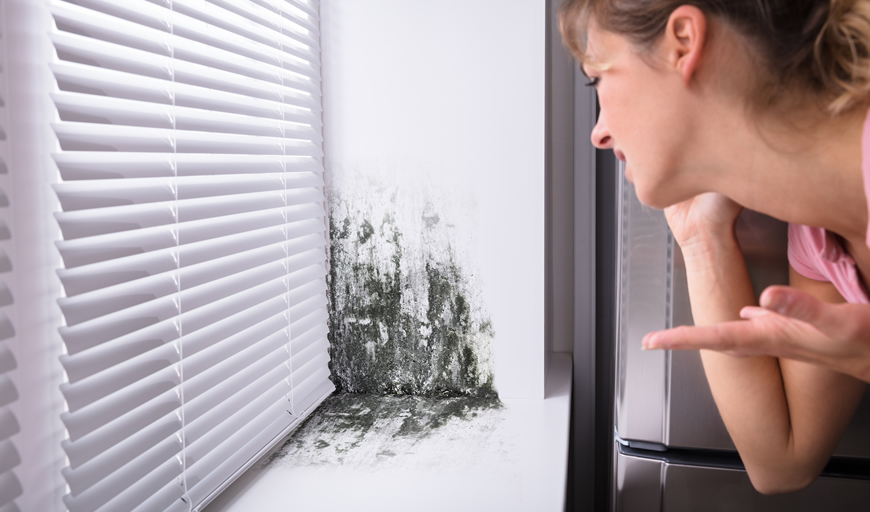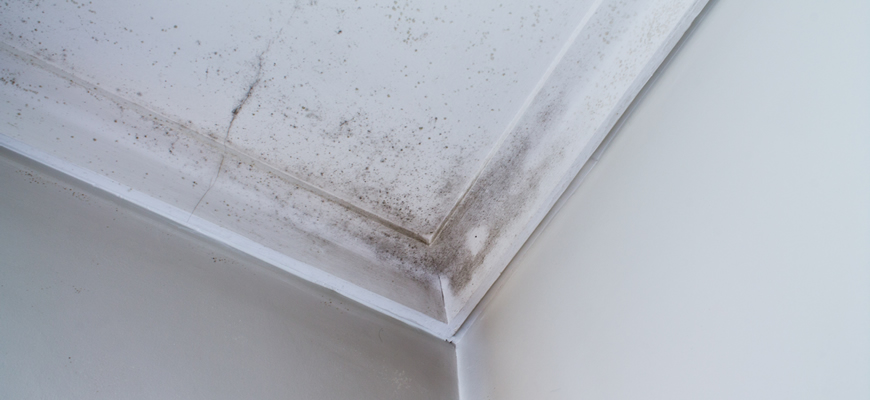Mould is Threatening the Health of Australians in their Own Homes

Experts are warning that Australians don't realise how dangerous household mould issues can be to their health, and there has been a call for building code changes to address the damp housing crisis that looms large in Australia.
We live a more closed-in lifestyle, nowadays, to try to achieve better energy efficiency and in many homes, no-one is at home during the day to allow for the house to be opened up and ventilated. This means Australian homes have become the perfect breeding ground for mould.
Australia seems to have learned very little from the leaky home crisis in New Zealand, which cost their economy $12 billion, and in Canada, costing over $4 billion.
What Causes a Mould in Homes?
Mould needs a combination of very common events to bloom from spores in the air. A food source, moisture and stagnant air are the main ingredients for mould to grow.
Most homes offer this perfect environment, particularly newer builds due to the reduction in air leaks and thus air movement. Bathrooms with limited ventilation, kitchens with limited ventilation and bedrooms due to respiration; are all likely areas of the home to find mould if ventilation is the problem.
Other moisture sources such as leaks are dampness can be a significant contributor to mould problems.
How to Check for Mould
You may smell mustiness, you may see if behind furniture, your clothes from the wardrobe might smell a little funky. Look behind furniture, behind paintings, wherever there is very little air movement. Check your attic, check under the floorboards.
Particularly check the bathroom, under the sink, check for loose tiles. Mould is often very visible and forms black spores on ceilings, walls and window frames. Fabrics can house hairy mould.
How to Get Rid of Mould
Eliminate the moisture source. Ventilate, open the windows, get air flowing, preferably dry air. Mould does not live in dry conditions.
Wash the surfaces with a good mould killer or you can use white vinegar. Remove wet and damaged materials and fabrics.
Consult an expert if the problem persists. Consider how the problem arose, and put prevention measures in place.
What to do if the Mould Problem Persists
Call a builder, to see if there is more, if there is any structural damage, and if they can remove it. Find the source of the problem; start with ingress of water from leaks.
Then consider internal air moisture, are there vents in place, is there enough fresh air being supplied to the building. Is there moisture build up on cold bridging materials; windows, window frames, steel, walls? An expert opinion is worth gold in these situations.
 A ceiling with mould seems innocent, but could be affecting your health.
A ceiling with mould seems innocent, but could be affecting your health.
What Harm Can Mould Do?
Fabrics – Fabrics that maintain moisture and subsequently get mouldy, will generally need to be chucked out. Some fabrics that have smoother surfaces such as wood, tiles, window frames, can usually be saved by cleaning thoroughly.
Building Structure – A Structural engineer or other specialist will need to determine if there is major damage to the structure from moisture. Often, mould or fungus can be a tell0tale sign of structural damage due to moisture problems. Consult an expert.
Human Health – Even short-term exposure to mould can cause cold and flu-like symptoms, but it can also lead to infections in those with serious illnesses or compromised immune systems. Ultimately, the longer someone is exposed to mould, the sicker they will get.
Living with mould can be detrimental to health. There has been some recent traction on the subject of mould from TV and at Government level due to the diagnosis of CIRS (Chronic Inflammatory Response Syndrome) which can affect 24% of people who breathe mould spores.
“An acute and chronic, systemic inflammatory response syndrome acquired following exposure to the interior environment of a water-damaged building (WDB) with resident toxigenic organisms, including, but not limited to fungi, bacteria, actinomycetes and mycobacteria as well as inflammagens such as endotoxins, beta glucans, hemolysins, proteinases, mannans and possibly spirocyclic drimanes; as well as volatile organic compounds (VOCs).” – Dr Ritchie Shoemaker.
CIRS has gone undiagnosed in many people for years, only 1500 people have been diagnosed in Australia to date, but it is expected that that figure in fact is undiagnosed in possibly 6 figure numbers of people.
Symptoms can include fatigue, weakness, aches, muscle cramps, unusual pain, ice pick pain, headache, light sensitivity, red eyes, blurred vision, tearing, sinus problems, cough, shortness of breath, abdominal pain, diarrhoea, joint pain, morning stiffness, memory issues, focus/concentration issues, word recollection issues, decreased learning of new knowledge, confusion, disorientation, skin sensitivity, mood swings, appetite swings, sweats (especially night sweats), temperature regulation or dysregulation problems, excessive thirst, increased urination, static shocks, numbness, tingling, vertigo, metallic taste, tremors, multiple chemical sensitivities.
How to Prevent Mould
Prevention begins at the design stage of building, use a reputable designer, have the building well detailed prior to construction. Use a builder you trust, who is educated on the products being used in the building. Ensure the ‘weak’ areas of the building are properly detailed, windows need to be flashed, not simply silicone in place. Ensure the exterior of the building has a cavity for moisture control.
Buildings are easily detailed to prevent moisture ingress, this is basic building practice for centuries, however new products, lack of education and most of all; lack of CARE recently has seen a rise in moisture ingress through windows, joints, doors, and roofs.
With increased insulation and air-tightness in building envelopes, another, often overlooked, potential issue will occur unless properly controlled and managed.
Your home develops moisture in the air from bodies, cooking, showers etc. With higher insulation properties the inside temperature of a home in winter is up to 3.5° warmer than 10 years ago (UK study). Warmer air has capacity to store more moisture than cool air, therefore moisture management is crucial.
If we take a minimal 1mm gap in insulation, this a space for the internal warm are to pass through the wall, in turn meeting, with the external air temperature somewhere along the wall causing a temperature drop and condensation to occur, otherwise known as ‘dewpoint’. This is interstitial condensation, trapped between the layers of the building envelope, and will cause mould growth, deterioration of the insulation and possible structural degradation.
So it is imperative to build air tight, with continuous insulation, i.e. no gaps. An air tight layer should be on the warm side of the insulation. This will stop vapour from penetrating the structure.
Current and older building methods, including double brick, timber and steel framing are littered with gaps. Reducing and eliminating these gaps will stop vapour penetrating into the structure and condensing, which can cause mould and degradation within the structure.
Current Building Issues
Poor building methods, uncontrolled building methods – no inspections during construction, designers and builders are not educated on the subject.
CARE; This is a massive problem and it is our belief that if you don’t care about the health and the welfare of the people these buildings are being sold to and housed in, then you shouldn’t be allowed in the industry.
At SIPs Industries, we care about you and building a better, healthier home.
The Future of Building
With a greater focus on energy efficient buildings, there are no shortage of building products to meet the requirements to build highly insulated framework, better glazing, better doors and so on. It is important to remember that all these new products will make your building far more air-tight than ever before. By doing so, air movement and natural ventilation are compromised.
Conscious decisions should be made on how the building is going to be ventilated. 10-15 litres of fresh air per person, per second for residential and a recommended 20 lts/sec for workplaces.
Fresh air can be brought into a building through an energy recovery unit, this unit will adjust the incoming air temperature to almost that of the current indoor temperature by passing the outgoing stale air. This will save a lot of energy on heating and cooling over time.
So, What Now?
Until the National Construction Codes realise there is a building detailing issue, and establish building codes to address the problems, it is up to us; the designers, and the builders to ensure moisture ingress and egress is addressed at the design and build stages of projects.
Case Study:
A Large Scale High Rise Development south of Perth City – Designed by a multinational architectural firm, building works by an Australian Wide large scale building company. We looked at the external wall details and found that within 3 years, there will be mould in the walls.
This is plainly due to four factors, poorly educated designers, developer driven unrealistic budgets, the builder’s ill education on the matter, and care. The fourth point is the hardest pill to swallow.
CARE. Even though sick Buildings have been well documented across the world, and across Australia, the correct people don’t care.
Click here to read our article about air leakage and moisture in the building envelope.
Contact SIPs Industries on (08) 9494 2211 for more information and to chat about the many benefits of building your home with SIPs.
